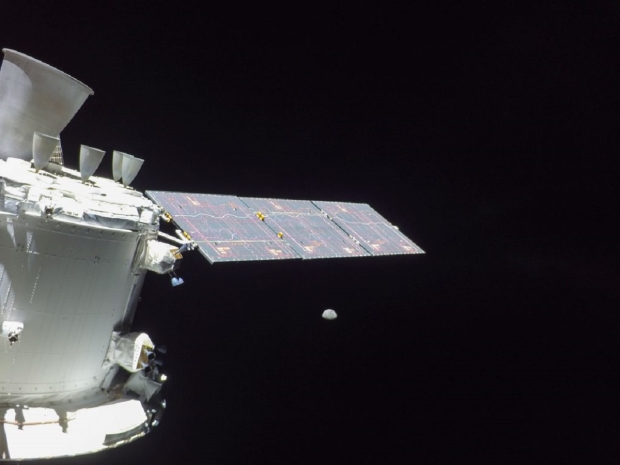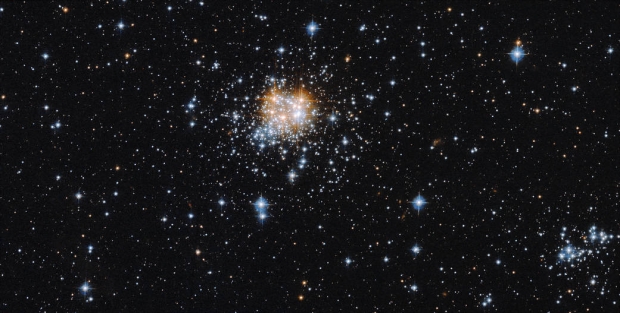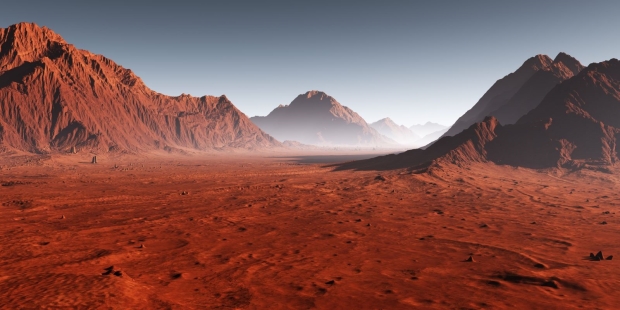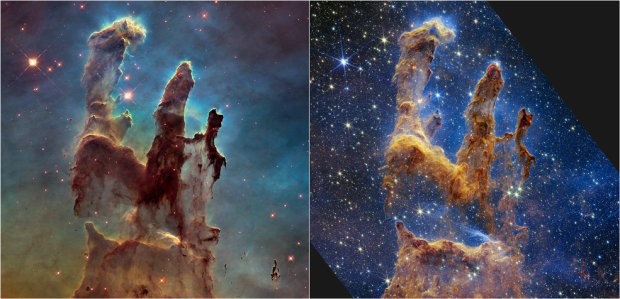Science, Space, Health & Robotics News - Page 2
NASA gives update on Artemis 1 mission, Orion spacecraft to return back to Earth
NASA has taken to its blog to provide an update on its Orion spacecraft which is currently on its way back to Earth for a scheduled splash down on December 11.
The space agency explains that Orion is currently on track to have a more than successful mission as the spacecraft has already completed its primary mission objectives while also completing some bonus objectives throughout its journey. However, NASA isn't ready to sign off on everything yet as the space agency is still to test its priority one and priority three objectives, with priority one being the day that Orion re-enters Earth's atmosphere and priority three being to retrieve the spacecraft.
NASA explains in a blog post that engineers will be performing a survey of Orion's crew module and service module with each of the cameras that are positioned on the spacecraft's four solar arrays. The engineers will be inspecting each part of the spacecraft and examining the 1,300 thermal protection system tiles that are designed to protect Orion from burning up on re-entry.
NASA captures record-breaking video of helicopter flying on the surface of Mars
NASA's Ingenuity helicopter, which is currently deployed on the surface of Mars, has set a new maximum altitude record of 46 feet.
The Ingenuity helicopter was deployed to Mars as part of NASA's Mars 2020 mission, which seeks to explore the Red Planet and search for signs of past microbial life. The helicopter was designed to be a technology demonstration, with the goal of demonstrating the feasibility of powered flight on Mars, which has long since been achieved time and time again.
On May 22, 2021, the Ingenuity helicopter took off from the Martian surface and flew to a height of 16 feet, before hovering for 30 seconds. This marked the first time that a powered, controlled flight had been achieved on another planet, and now the helicopter is breaking its own records.
Blue Marble: the iconic photo that inspires us to protect our planet
The Blue Marble photograph, taken by the Apollo 17 spacecraft on December 7, 1972, is an iconic and inspiring image.
The photograph shows the Earth in all its beauty and majesty, with the deep blue of the oceans, the white of the clouds, and the browns, greens, and whites of the continents all visible. The photograph was taken during the final moon mission of the Apollo program, as the spacecraft was departing from the moon's orbit. As the spacecraft flew around the far side of the moon, the astronauts were able to capture the first-ever photograph of the Earth that showed the entire planet.
The Blue Marble photograph has been credited with helping to spark the modern environmental movement. Seeing the Earth from space, with no political boundaries or other distinctions visible, gives a sense of the planet's fragility and interconnectedness. This has inspired many people to work towards protecting the environment and preserving the planet for future generations.
Continue reading: Blue Marble: the iconic photo that inspires us to protect our planet (full post)
NASA's Hubble examines outstanding star cluster 160,000 light years from Earth
NASA's Hubble Space Telescope is more than 30 years old but is still producing jaw-dropping images of the cosmos.
NASA has taken to its website to showcase an image of star cluster NGC 2002, located 160,00 light years from Earth, within the Large Magellanic Cloud, which is a satellite galaxy of our Milky Way. The space agency explains that NGC 2002 is approximately 30 light-years in diameter and is relatively young at just 18 million years old.
NGC 2002 contains about 1,100 stars, and according to NASA, the star cluster is an "open star cluster", which means that it has "low star density" and features an irregular shape as a result of the overall low gravitational attraction from the stars within the region. The opposite of an open star cluster is a globular cluster, which is when all of the stars are clumped tightly together, making it sometimes impossible for astronomers to observe individual stars.
NASA posts video showing the Orion spacecraft just 687 miles above the Moon
NASA has taken to its social channels and website to provide an update on its Orion spacecraft, which is currently preparing for its last maneuver before heading back home to Earth.
The space agency has explained in its Artemis 1 Flight Day 19 update via its website that on December 4 the Orion spacecraft performed a trajectory correction burn that put the spacecraft on-route to make its closest approach to the Moon before it began its long journey back to Earth. According to NASA, the Orion spacecraft will come within just 79.2 miles of the surface of the Moon, with the space agency posting a video to its Artemis Twitter account showing Orion on its way to making its closest approach yet.
NASA continues to explain that on the same day, Orion will perform a powered fly burn at 10:43 am CST, which will last 3 minutes and 27 seconds. This burn will change the velocity of the spacecraft by approximately 655 mph (961 feet per second) and will be the maneuver of the mission before Orion heads back to Earth. NASA writes that on its way back, Orion will make slight trajectory adjustments, but nothing major.
Scientists expose the beating heart of a distant galaxy in a mesmerizing photo
Researchers are testing the Enhanced Resolution Imager and Spectrograph (ERIS), and according to a recent press release, the new scientific instrument has peered into the heart of a distant galaxy and captured its center in mesmerizing detail.
The European Space Agency's (ESA) Enhanced Resolution Imager and Spectrograph (ERIS) instrument is a 27-foot infrared space telescope that's installed on the ESO's Very Large Telescope located in northern Chile and a part of its first set of test observations, which were completed back in February of this year, ERIS has imaged a distant galaxy called NGC 1097, located approximately 45 million light-years from Earth.
NGC 1097 is located within the constellation Fornax, and ERIS was able to capture the inner ring of the galaxy, revealing the supermassive black hole at the galaxy's center. The large inner ring features stellar nurseries, represented by the bright spots located along its edge. The ESO writes that NGC 1097's supermassive black hole is feeding off its surroundings.
80-story-tall megatsunami from asteroid impact desolated the surface of Mars
An asteroid approximately the size of the one that finished off the dinosaurs collided with the surface of Mars, causing a massive tsunami that changed hundreds of thousands of square miles.
The new study describes the great tidal waves as megatsunamis, with previous research attributing two megatsunami events triggered by two asteroid impacts that happened approximately 3.4 billion years ago. In an older study, researchers pointed to a 75-mile-wide crater called the Lomonosov Crater for the location of an asteroid impact that caused one of these massive waves.
Scientists estimated that the asteroid that created the Lomonosov Crater created a tsunami that covered 309,000 square miles of land. Newer research is indicating that a second megatsunami that covered 386,000 miles of land was caused by an asteroid that carved a 69-mile-wide Pohl Crater. The massive diameter of the Pohl Crater leads researchers to believe that the asteroid that created it was about the same size as the 6-mile-wide asteroid that wiped out the dinosaurs.
US Air Force unveils $700 million 'most advanced military aircraft ever built'
The US Air Force has unveiled a new stealth bomber that is being described as the "most advanced military aircraft ever built".
The United States Air Force has unveiled its first new bomber in more than 30 years, the B-21 Raider, developed by Northrop Grumman, is a stealth bomber that was recently showcased at an invite-only event. An Air Force spokesperson informed Air Force Magazine of the unveiling and said that the aircraft isn't expected to take to the skies until next year.
Notably, Northrop Grumman will be conducting its own unveiling of the aircraft on December 2, and the event was streamed to YouTube. During the presentation, Northrop Grumman claimed that the B-21 Raider is the "world's first sixth-generation aircraft", putting it far beyond any other current aircraft in terms of capabilities than what is known to the public.
NASA's Webb captures the most detailed image of the Pillars of Creation ever
NASA's James Webb Space Telescope still continues to impress the public with its incredible images of the cosmos, as the space telescope has focused its highly advanced instruments on the Pillars of Creation once again.
Hubble's image of the Pillars of Creation on the left, Webb's first image on the right
The new image was posted to the European Space Agency (ESA) website on December 1 and reveals the most-detailed image of the iconic Pillars of Creation taken so far. Located between 6,500 to 7,000 light-years away from Earth, the Pillars of Creation are an iconic location in the cosmos as it was famously captured by the Hubble Space Telescope in 1995. NASA's Webb is now performing follow-up observations, comparing new photos to Hubble's to show the difference in observational capabilities.
The Pillars of Creation has already been imaged by Webb twice, the first image released by NASA was snapped with Webb's Near-Infrared Camera (NIRCam) and can be found below. The second time was on October 30 for Halloween, when NASA and the ESA published an image snapped with Webb's Mid-Infrared Instrument (MIRI). Both of the images highlighted different aspects of the Pillars of Creation, showcasing its beauty in different wavelengths of light.
SpaceX's Starship completes static fire test, closing in on first orbital launch
SpaceX is making progress toward the first orbital launch of its Starship launch vehicle, as the company recently conducted a successful static fire test.
SpaceX took to its Twitter account to announce that Booster 7 has completed a long-duration static fire test that featured eleven Raptor 2 engines. The static fire test was successful and a step forward in SpaceX's journey to getting Starship to orbit, and it may very well be the second to last static fire test the company conducts before the orbital test launch.
SpaceX started the test at 2:42 pm on November 30, blasting 11 Raptor 2 engines for just 13 seconds. This latest test featured fewer Raptor 2 engines than SpaceX's previous static fire test on November 14, which featured 14 Raptor 2 engines. Notably, Booster 7 has a total of 33 Raptor 2 engines, which SpaceX is yet to test all at once. Presumably, Elon Musk's company will test all 33 of the next-generation engines before attempting the first orbital test flight for Starship.







